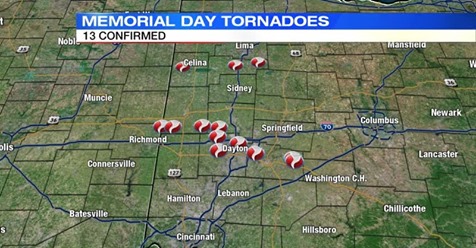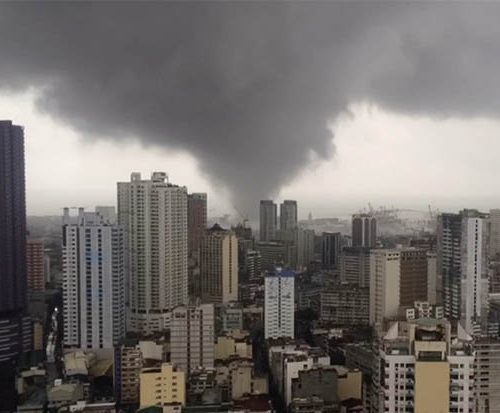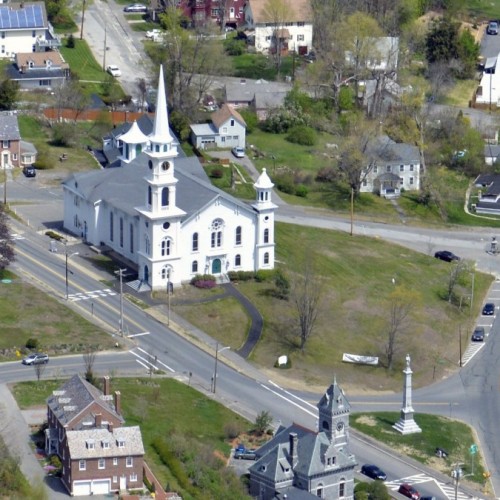(CNN)There was some good news to come out of 2020: fewer tornadoes and fewer lightning strikes across the United States. But sadly, fewer tornadoes did not mean fewer fatalities — a stark reminder that the timing and location of such storms can be critical.
With a preliminary tally of 1,053, 2020 saw the lowest annual number of tornadoes since 2015, when 971 were recorded, according to the National Oceanic and Atmospheric Administration’s Storm Prediction Center.
Still, tornadoes last year killed 78 people, the highest count since 2011, when a super outbreak in late April led to 553 deaths.
Similarly, two events in 2020 contributed to the majority of last year’s fatalities. In the first — March 2 into 3 — 10 tornadoes rolled through Tennessee, including Nashville, killing 24 people.
“Tornadoes that occur in more populated regions, such as in or near cities, are much more likely to result in deaths due to the sheer number of people in the path,” says Brandon Miller, CNN meteorologist.
“The time of day also plays a role,” he says. “Nocturnal tornadoes, which occur at night while most are sleeping and unaware of warnings and changing conditions, are much more likely to result in deaths compared to tornadoes that occur during daylight hours.”
The following month ended up being the second-most active April on record for tornadoes, behind only 2011 for total number. Every day in April but one — April 5 — saw at least a Marginal Risk (level 1 of 5) for severe storms somewhere across the contiguous US, according to the Storm Prediction Center.
2020’s second significant outbreak — on April 12 and 13 — produced more than 140 tornadoes. It was also the deadliest tornado outbreak in six years, with 32 fatalities across Tennessee, Mississippi, Georgia and South Carolina.
“In a lot of ways, tornadoes are like hurricanes, with the damage and fatalities related to where they strike,” says Dave Hennen, CNN meteorologist. “Think of Hurricane Andrew in 1992: the first storm, the A storm, that didn’t occur until late August. But because it was so strong and hit a densely populated area of South Florida, that year will always be remembered.
“Tornadoes are the same way. Some of the strongest tornadoes every year occur in rural parts of the country, so damage can be limited, but if a tornado, even a weaker one, strikes a major metro area, damage and fatalities can be extensive,” he says. “So, it’s not number that is most important but where it hits.”
There were 14 killer tornadoes in April 2020. Then, into May 2020, a shift in the weather pattern began to favor development of strong troughs in the eastern US.
“The end result is that the central United States never had an extended period of time where we had all four primary ingredients for severe thunderstorms and tornadoes in place for any extended length of time, during what is normally the most favorable time period for severe hail,” says Patrick Marsh, science support branch chief for the Storm Prediction Center.
Lightning numbers also decreased
Another potentially deadly weather phenomenon — lightning strikes — also saw tallies drop in 2020. There were about 170 million lightning events last year across the continental US, down about 52 million from 2019, according to Vaisala’s 2020 Annual Lightning Report.
“The decrease in counts from 2019 to 2020 is the greatest change year-over-year in our data, and 39 (of the) 48 (states) saw below-average lightning,” says Chris Vagasky, meteorologist and lightning applications manager at Vaisala, which specializes in weather, environmental and industrial measurements on Earth and Mars.
Unsurprisingly, Texas ranks No. 1 in total lightning strikes, due in part to its huge land area, Vaisala reports. By square kilometer, though, Florida tops the list, with Texas sixth.
Iowa, Montana, New Mexico, and Wyoming all saw far fewer lightning strikes in 2020.
Sometimes a single event can account for a large number of lightning strikes. An example is the Midwestern derecho event last summer. It spawned 8% of all Iowa lightning strikes in 2020, with over 27,000 cloud-to-ground strikes. Despite this, Iowa — which based off the average from 2010-2019 places 13th for most strikes — actually dropped to the No. 22 spot last year.
Other states saw big increases in lightning strikes in 2020. Georgia jumped four spots, cracking the Top 10 for only the third time. Ohio, Michigan and North Dakota also notched more lightning strikes last year, with over 2 million cloud-to-ground strikes each.
Preliminary numbers show lightning killed 17 people across the US in 2020, the second-lowest total since 2010, according to the National Weather Service.
While California’s tally of lightning was below average last year, the impact of lightning there in 2020 was tremendous, sparking wildfires that burned the largest portion of the state in history.
“Unfortunately, much of the lightning that occurred was during a four-day period in August (15 to 18) that was accompanied by very little rainfall,” Vagasky says.
Dry thunderstorms and wildfires don’t mix
Lightning in some Western states can be especially concerning in the summer months due to the potential for sparking wildfires. But not all lightning is created equal.
A factor called “continuing current” is very important. (Scientists sometimes use the term “stroke” when referring to lightning.)
“Most lightning strokes last on the order of microseconds, but some lightning lasts significantly longer and is known as ‘continuing current’ lightning,” says Vagasky. “These strokes transfer heat and electricity for a lot longer than typical lightning strokes and are more likely to trigger fires or cause damage.
“The scientific consensus is that around 10% of cloud-to-ground strokes contain continuing current.”
And lightning frequency isn’t the only consideration for fire weather.
“Other factors, including drought conditions, the amount of precipitation with the thunderstorms and whether the lightning contains continuing current … help dictate whether lightning will trigger wildfires,” says Vagasky.
Oftentimes as thunderstorms develop out West, the surrounding air is so dry that any rain that falls actually gets evaporated before it reaches the ground, a phenomena called “virga.” Lightning can still occur within these storms, which don’t have the benefit of moisture to extinguish any fires a strike might set.
by Allison Chinchar (2021, Jan 16) CNN




